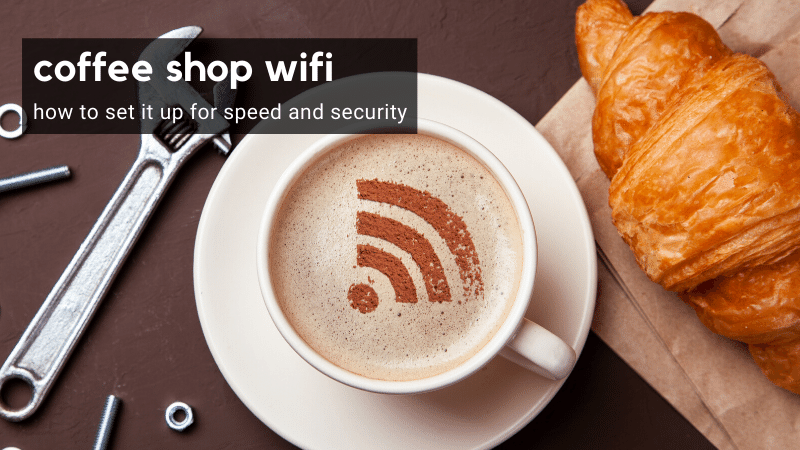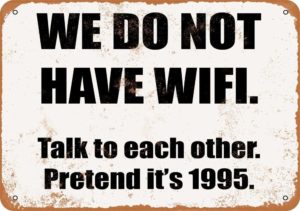Secure Your Coffee Shop WiFi: A Guide for Owners
Have you seen a sign like “No WiFi—Talk to Each Other Like It’s 1995”? Worse, do you have one?
In 2020—now 25 years past ‘95—that vibe doesn’t fly. It’s not nostalgia; it’s a jab that makes customers feel small, even if they’re not there for WiFi. A sign like that screams you’ll scoff at reasonable asks—like what is barista work if not serving today’s needs? Customers will wonder: “What else gets mocked here? Why spend my money?”
It’s 2025 now, and WiFi’s a coffee shop staple. But sloppy setups invite hackers eyeing passwords and card numbers. Sure, you can warn patrons off sensitive logins, but why risk the vibe—or lost business? At OnlineBaristaTraining.com, where we offer online barista training, we’ve got you covered. Here’s how to set up and secure your WiFi, protecting your shop and guests.
Wifi Basics
Confused by WiFi? Skip ahead if you’re a pro, but for newbies—let’s simplify. WiFi (Wireless Fidelity) or WLAN (Wireless Local Area Network) uses high-frequency waves to send data. Walls or cabinets can block the signal, so keep your router out in the open. A typical setup has four parts: internet connection, modem, router, and devices—like your POS or customers’ phones. Our barista course grads know tech matters as much as coffee.
Internet Connection: Your wall plug (think phone line). For a café, go fast and reliable—or slightly slower if you’re a small shop with quick table turnover. A sneaky barista training tip: decent WiFi keeps folks coming, but not camping.
Modem: Translates internet data for your router. Some combo modem-routers exist—check what your ISP offers. Beware junk gear or rental fees; research beats regret.
Router: Broadcasts your WiFi signal. A weak one chokes your speed—vital for coffee barista training tools like online orders. Shop smart.
Devices: Laptops, phones, your POS. Keep the latter off public WiFi—more on that soon.
Setting Up Public Wifi
Got the gear? Let’s make it customer-ready with barista classes online-inspired precision.
Basic Setup
First rule from our online barista course: split your networks. Create a private one for your POS (credit card data stays safe) and a guest network for patrons. Access your router’s settings via its IP (e.g., 192.168.0.1—check the label), log in with default credentials, and find the guest network option. Turn on the SSID so it’s visible, then set a password (tips below). Done right, it’s hacker-resistant and customer-friendly.
Advanced Options
Want more? These extras, honed in barista training courses, boost control:
Limiting Guests: Cap guest bandwidth to prioritize your POS. Check router settings for “Traffic Shaping” or ask your ISP. A slow Netflix stream won’t crash your sales.
Captive Portal: That “accept terms” page you’ve seen? It’s branding plus liability protection if someone misuses your network. Some routers or ISPs support it; otherwise, an IT pro can help—worth it for peace of mind.
Security Made Simple
WiFi protocols sound techy, but here’s the rundown:
WEP: Ancient, crackable—avoid it.
WPA: Better, but outdated.
WPA2: The go-to. Secure enough for most, easy to set via your router.
The real shield? That private-versus-guest split. Still, nudge customers off sensitive logins—our barista lessons online stress trust builds loyalty.
Managing Wifi Access
Coffee shops balance a paradox: low-profit drinks versus lingering WiFi users. Restaurants and bars have higher tabs and quicker exits—cafés don’t. No WiFi risks losing folks (see that 1995 sign rant), but all-day campers hurt too. Solutions? Try WiFi-free days with a perk (like a breakfast boost) or keep the password at the register—buy-to-browse. Printing it on receipts works less as paper fades. Our coffee shop interview questions for managers often probe this balance.
Password Tips
Go strong (mix letters, numbers, symbols) but readable. “C0ff33Sh0p!” beats “A%kJ#9”—secure yet typable. Change it weekly or monthly—keeps it fresh and nudges repeat purchases. A barista certification trick: tie it to a promo for fun.
Picking Your Internet
Your ISP choice hinges on location and needs. Reliability trumps all—slow but steady beats fast and flaky. Research local reviews, especially from businesses. Speed-wise, focus on download (customer browsing) and upload (POS transactions). Streaming hogs bandwidth—block YouTube if needed.
Quick Speed Guide:
Safe Minimum: 30 Mbps (block streaming)
Respectable: 100-200 Mbps
Top-Tier: 600+ Mbps
Types (fastest to slowest): Fiber > Cable > DSL > Satellite > Dial-up (8 Mb = 1 MB; 1000 MB = 1 GB = 8000 Mb)
Brew Success With Smarter Wifi
Ditch the snarky signs—WiFi’s a draw, not a drag. Secure it right, and you’ll keep customers safe and happy. Need more café savvy? Our online barista training, barista classes online, and barista training courses at OnlineBaristaTraining.com equip you—and your team—for every challenge. From interview questions for a cafe to tech tips, we’ve got your back. Start brewing a better shop today!
Join a virtual café to learn WiFi tricks for coffee pros.
Secure your setup with coffee business tech advice.



